Phantasmagoria
Part Two: Marx and the Fetish
Chapter Five
At
the British Museum
In June of 1850 Karl Marx
obtained a ticket to the Reading Room of the British Museum. He had arrived in
London the previous year as a political exile, a refugee from a revolution that
failed but that shook the world nonetheless.
 In 1848 the Parisian masses detonated an international explosion when
they overthrew the constitutional monarchy of Louis Philippe. Gathering under
the red flag, they demanded a "social republic" that would guarantee material
security and good working conditions as well as political liberty. Following
their example, plebeian townspeople all over Europe held meetings, organized
marches, erected barricades, and fought, often successfully, against the regular
armies of the old regimes. Representative assemblies formed in opposition to
royal and aristocratic power as middle-class republicans joined radical workers
and artisans in insurgent though uneasy alliances. In concert with the urban
uprisings, peasants mobilized in the countryside against age-old feudal bonds,
demanding land as well as the most basic political freedoms. In Italy, Hungary,
Poland, and elsewhere, subjugated nations rose against foreign domination in
what became known as "the springtime of the peoples." In number of participants,
as well as sheer geographical extension, the revolution of 1848 was completely
unprecedented. Before it was over, it had involved millions of people in more
than fifty European states.
In 1848 the Parisian masses detonated an international explosion when
they overthrew the constitutional monarchy of Louis Philippe. Gathering under
the red flag, they demanded a "social republic" that would guarantee material
security and good working conditions as well as political liberty. Following
their example, plebeian townspeople all over Europe held meetings, organized
marches, erected barricades, and fought, often successfully, against the regular
armies of the old regimes. Representative assemblies formed in opposition to
royal and aristocratic power as middle-class republicans joined radical workers
and artisans in insurgent though uneasy alliances. In concert with the urban
uprisings, peasants mobilized in the countryside against age-old feudal bonds,
demanding land as well as the most basic political freedoms. In Italy, Hungary,
Poland, and elsewhere, subjugated nations rose against foreign domination in
what became known as "the springtime of the peoples." In number of participants,
as well as sheer geographical extension, the revolution of 1848 was completely
unprecedented. Before it was over, it had involved millions of people in more
than fifty European states.
Marx fought on the socialist
left wing of the revolution in a number of capacities and in more than one
country, but nowhere more brilliantly than in his native land as editor of the
radical Rhineland newspaper, the Neue Rheinische Zeitung, the "organ of
democracy," as its masthead proclaimed. When the revolution was defeated in
Germany in 1849, as it was throughout Europe, the Prussian government expelled
Marx as a stateless person. He initially went to Paris where his wife and
children were living, but the newly installed reactionary French government soon
ordered him to relocate to Brittany. For a radical intellectual, however, the
prohibition against residing in the capital city was as good as a demand to
leave France. This is how it came about that in August of 1849 Marx fled with
his family to England and showed up a year later at the British Museum.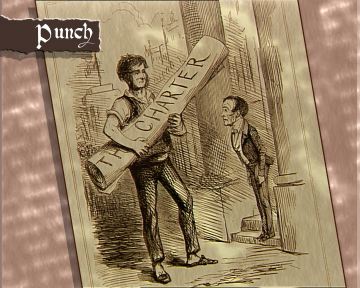
Unbeknownst to Marx, the
Museum had played a small and rather comic role in the tumultuous events of
1848. It is true that there had been no revolution in England. but for
approximately a decade, the laboring poor had conducted a militant campaign for
political reform under the auspices of the Chartist movement. By means of
demonstrations, marches, petitions, and threats of a general strike, the
Chartists agitated for such fundamental democratic measures as universal male
suffrage, abolition of the property qualification for a seat in Parliament, and
vote by secret ballot. Though the Chartists sought political rather than social
reforms, they did not hesitate to condemn economic inequality in their speeches
and pamphlets. Prominent members of the English bourgeoisie regarded them as a
serious threat to the established order, believing that once workers held the
right to vote, demands for the redistribution of wealth and common ownership of
productive resources would soon follow. In 1848 the outbreak of revolution on
the Continent accentuated the perception of a Chartist menace to the sanctity of
private property. This was so much the case that the Trustees of the British
Museum proved themselves incapable of distinguishing between the threat of
social appropriation of productive resources and that of outright looting. The
Chartists announced that they would hold a massive demonstration on April 10 at
Kensington Common, 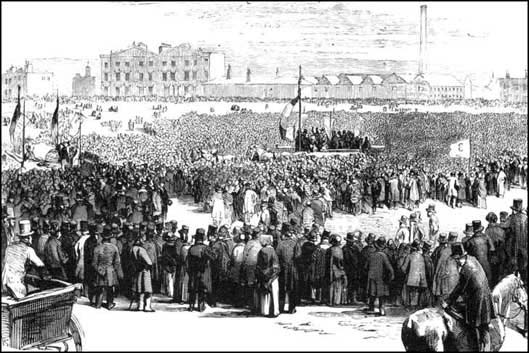 and that the members of their Western Division would first
gather in Russell Square, near the Museum. Sensing danger to the property in
their care, the Trustees arranged to have it defended by force of arms. In the
words of W.H. Boulton, a historian of the Museum: "The staff were sworn in as
special constables, and with some soldiers and pensioners from Chelsea Hospital
they assembled in the Museum to defend its treasures. Muskets, ammunition, and
cutlasses were supplied and provisions laid in lest there should be a siege of
the British Museum."[1] Of course, no siege occurred since the Chartists
never had any intention of launching an assault in the first place. In addition
to this comedy of overreaction, there is an irony here. While the Trustees took
such extreme steps to protect their holdings from a nonexistent Chartist threat,
they soon made their literary treasures freely available for Marx's
revolutionary use by issuing him a ticket to their Reading Room.
and that the members of their Western Division would first
gather in Russell Square, near the Museum. Sensing danger to the property in
their care, the Trustees arranged to have it defended by force of arms. In the
words of W.H. Boulton, a historian of the Museum: "The staff were sworn in as
special constables, and with some soldiers and pensioners from Chelsea Hospital
they assembled in the Museum to defend its treasures. Muskets, ammunition, and
cutlasses were supplied and provisions laid in lest there should be a siege of
the British Museum."[1] Of course, no siege occurred since the Chartists
never had any intention of launching an assault in the first place. In addition
to this comedy of overreaction, there is an irony here. While the Trustees took
such extreme steps to protect their holdings from a nonexistent Chartist threat,
they soon made their literary treasures freely available for Marx's
revolutionary use by issuing him a ticket to their Reading Room.
Twenty-three thousand books,
prints, and manuscripts had been part of the original bequest from Sir Hans
Sloane that established the British Museum in 1753.[2] By the time Marx obtained his ticket, the
Museum's collection had grown to include four hundred thousand books alone and
ranked sixth among the great libraries of the world.[3] And by the time he published the first volume
of Capital in 1867, the library had swelled to fully one million volumes under
the enthusiastic directorship of its Principal Librarian, the Italian
expatriate, Sir Antonio Panizzi. Panizzi was also responsible for transforming a
rather haphazard collection of materials into an exceedingly well-organized one
through the development of a systematic catalogue.[4] The catalogued library was indispensable to
Marx in his research in political economy. It was the surgical instrument that
allowed him to probe the anatomy of capitalist society.
Marx began this effort in the
summer of 1850 by reading back issues of the Economist. He was trying to
answer the question that was of paramount concern at the time to the socialist
movement and indeed the whole European left: why had the revolution of 1848
failed? He found his answer in the magazine's reports on price and currency
fluctuations, investment trends, and recent technological developments. He had
been able to revive the Neue Rheinische Zeitung for a short period of
time in the form of a quarterly journal. In articles in several of its issues
Marx argued that a crisis of overproduction in the immediately antecedent period
had prepared the way for the explosion of 1848. Even the new railroads were
incapable of absorbing all of the available surplus capital. As a result,
markets became saturated and production declined. By 1849, however, the crisis
had run its course and global economic activity revived, especially with the
discovery of gold in California. That is why the revolutionaries had been unable
to consolidate their initial gains. It was clearly not possible to overthrow the
dominant order while its guardians were celebrating the return of good times, a
celebration that attained palpable form in British plans for the World
Exposition of 1851, which Marx went so far as to call a new "Pantheon in the
modern Rome."[5] "While this general prosperity lasts," he wrote
in one of his articles, "there can be no question of any real revolution." In
the same piece he went on to claim: "A new revolution is only possible as the
result of a new crisis: but it will come just as surely as the crisis
itself."[6]
While Marx was pouring through
back issues of the Economist he was still living with his suitcase
packed, like the vast majority of exiled revolutionaries. But as time wore on
and economic stability deepened, he came to recognize that 1848 was not going to
renew or repeat itself any time soon. Quickly wearying of the claustrophobic
personality conflicts endemic to émigré politics, he withdrew into his work. In
order to support himself, he began writing weekly articles as European
correspondent for the American abolitionist newspaper, The New York Daily
Tribune. More importantly, he revived an earlier plan for a book on
political economy. Both activities led him to intensify his research at the
Museum.
From the very beginning, the
British Museum had an emotional significance for Marx in addition to an
intellectual one: it offered him respite from misery. His earnings as a
journalist were paltry, and supplementary stipends from Engels were too small to
lift him out of poverty, at least until the last few years of his life. Hounded
by creditors and landlords, he was a frequent visitor to pawnshops where he was
sometimes forced to deposit even his coat and shoes. He lost three children to
illness because of lack of money for proper medical care. Like his mythical hero
Prometheus, who had also rebelled against the existing order, he had problems
with his liver. As a result he was plagued with boils. Anxiety in combination
with a congenital disorder prevented him from getting more than a few hours of
sleep at night. For years he lived with the five other members of his family in
two small rooms in a proletarian district in London. But his home was on Dean
Street, no more than a ten minute walk from the Museum. When he was healthy
enough and in possession of his shoes, he would arrive at ten in the morning and
not leave for home until seven in the evening. The Museum was the place where he
was able to get away from the squalor of daily existence, the sanctuary where he
could forget his own suffering for awhile as he examined the causes of the
prevailing social misery.
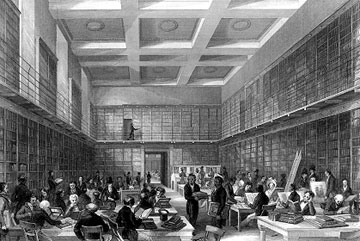 During Marx's first seven years in England, the Reading Room was
located in a cramped, musty space in the north wing of the Museum. Even though
its twenty-six tables were able to accommodate only two hundred and eight
people, there was little attempt to reserve the spots for traditional scholars.
A full range of what Antonio Gramsci was later to call "organic intellectuals"
took advantage of the facilities. In 1852, Bentley's Miscellany
characterized the Reading Room's motley inhabitants with disdainful bourgeois
humor: "Every class of persons haunts the place from the literary lawyer's clerk
to the revolutionary notorieties of Europe. There are hebdomadal humorists
purloining jokes, third-rate dramatists plundering plots, girls copying heads
and flowers."[7] In spite of the close quarters, this was just
the kind of setting where Marx would be likely to feel at home.
During Marx's first seven years in England, the Reading Room was
located in a cramped, musty space in the north wing of the Museum. Even though
its twenty-six tables were able to accommodate only two hundred and eight
people, there was little attempt to reserve the spots for traditional scholars.
A full range of what Antonio Gramsci was later to call "organic intellectuals"
took advantage of the facilities. In 1852, Bentley's Miscellany
characterized the Reading Room's motley inhabitants with disdainful bourgeois
humor: "Every class of persons haunts the place from the literary lawyer's clerk
to the revolutionary notorieties of Europe. There are hebdomadal humorists
purloining jokes, third-rate dramatists plundering plots, girls copying heads
and flowers."[7] In spite of the close quarters, this was just
the kind of setting where Marx would be likely to feel at home.
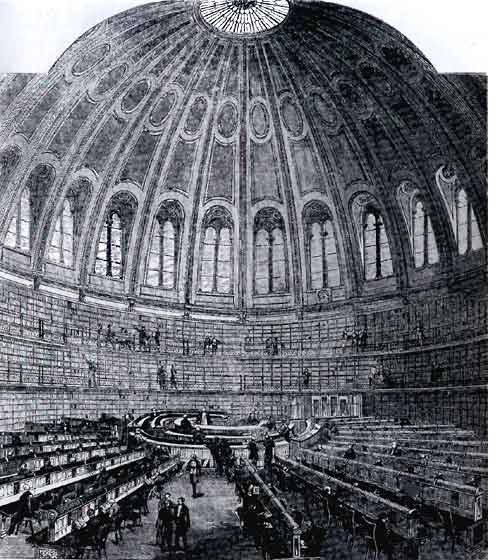 Still, a crisis point was reached as congestion became acute. At the
same time that the users of the Library came close to exceeding the Reading
Room's limited spatial resources, the collection itself was experiencing the
rapid growth of Panizzi's tenure. So in 1852, the Principle Librarian produced a
sketch for a new and bigger Reading Room.[8] It was to be circular in shape and occupy the
currently empty central quadrangle of the Museum. Panizzi handed his sketch over
to the architect Sir Robert Smirke who refined it into a design for an enormous
dome to be made from the same materials used in the celebrated Crystal Palace:
glass and cast iron. Smirke's version of the Reading Room opened for public use
in 1857. It would have deserved to share the title that Marx had bestowed seven
years earlier on the World Exposition — the "Pantheon in the modern Rome"— since
the Pantheon was the only dome in the world that had a circumference that was
larger, and only by three feet. Spacious, bright, and well-ventilated, the newly
built chamber was able to accommodate four hundred and fifty eight persons at
padded writing desks equipped with chairs of mahogany and leather. Marx
conducted the bulk of his research for Capital in these comfortable
surroundings.
Still, a crisis point was reached as congestion became acute. At the
same time that the users of the Library came close to exceeding the Reading
Room's limited spatial resources, the collection itself was experiencing the
rapid growth of Panizzi's tenure. So in 1852, the Principle Librarian produced a
sketch for a new and bigger Reading Room.[8] It was to be circular in shape and occupy the
currently empty central quadrangle of the Museum. Panizzi handed his sketch over
to the architect Sir Robert Smirke who refined it into a design for an enormous
dome to be made from the same materials used in the celebrated Crystal Palace:
glass and cast iron. Smirke's version of the Reading Room opened for public use
in 1857. It would have deserved to share the title that Marx had bestowed seven
years earlier on the World Exposition — the "Pantheon in the modern Rome"— since
the Pantheon was the only dome in the world that had a circumference that was
larger, and only by three feet. Spacious, bright, and well-ventilated, the newly
built chamber was able to accommodate four hundred and fifty eight persons at
padded writing desks equipped with chairs of mahogany and leather. Marx
conducted the bulk of his research for Capital in these comfortable
surroundings.
The plan to develop a critique
of political economy that would also serve as an account of the underlying "laws
of motion" of capitalism goes back, at least in embryo, to 1844. Marx was in
Paris at the time and intensively reading such celebrated economic theorists as
Adam Smith, Sismondi, Say, and James Mill. In the Economic and Philosophic
Manuscripts, he tried to show that the basically apologetic treatment of
wages, profits, and ground rent given by the classical economists lent itself to
an interpretation far more radical than the one they intended. For these
economic categories attained their genuine significance only in terms of a
deeper analysis of alienated labor, which was itself the secret behind the
dehumanization of bourgeois society. The Manuscripts were preliminary
studies never intended for publication: Marx wrote them in preparation for a
book on economics. But he had to interrupt his plans for a published treatment
as organizational demands intensified with the approach of 1848. With the defeat
of the revolution and the enforced idleness of exile, he was able to resume his
theoretical labors. As early as April of 1851, he announced that his project was
nearing completion. In a letter to Engels he wrote: "I am so far advanced that
in five weeks I will be through with the whole economic shit. And that done, I
will work over my Economics at home and throw myself into another science at the
Museum. I am beginning to be tired of it."[9] But the deeper Marx plunged into his
investigations, the more voluminous the material he had to comprehend and the
more difficult and confusing the task appeared to him. The "five weeks" grew
into months and the months into years.
Marx never intended his
"Economics" to be an exercise in detached scholarship. He was writing it in
order to provide theoretical and even strategic orientation for the
working-class movement. It is not surprising then that he accelerated his
efforts with the outbreak of a new economic crisis in 1857, especially since he
believed that revolution would not be far behind. He wrote Engels predicting
imminent completion once again: "I am working madly through the nights on a
synthesis of my economic studies so that, before the deluge, I shall 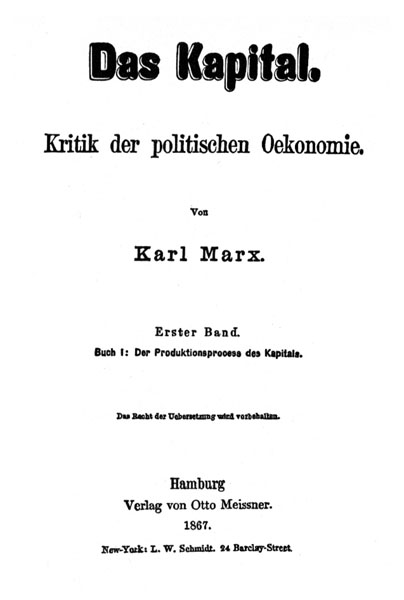 at
least have the outlines clear."[10] The deluge never came but Marx did manage to
finish at least a rough version of the "Economics" under the title, The
Outlines of the Critique of Political Economy (the Grundrisse) later
the same year. Although he found a publisher for the work, he decided that it
was too disorganized to release in its existing form. Instead in 1859 he
published its first chapter on money in a completely rewritten version as A
Contribution to the Critique of Political Economy. When the Marx-Engels
Institute in Moscow made the original manuscript widely available in the 1950s,
the Grundrisse appeared to be an almost contemporary document because of
its uncannily prescient analysis of automation. But it is equally important for
understanding the full scope of Marx's theoretical project. It includes a
prospectus for a six part work
consisting in treatments of 1) capital in general, 2) landed property, 3) wage
labor, 4) the state, 5) foreign trade, and 6) the world market and crisis. As it
turned out, Marx spent the rest of his life working on the first part only —
capital in general — and even then was able to complete merely the first volume
of a three volume treatise. The second and third volumes of Capital were
edited by Engels on the basis of Marx's notebooks and released after the
author's death.
at
least have the outlines clear."[10] The deluge never came but Marx did manage to
finish at least a rough version of the "Economics" under the title, The
Outlines of the Critique of Political Economy (the Grundrisse) later
the same year. Although he found a publisher for the work, he decided that it
was too disorganized to release in its existing form. Instead in 1859 he
published its first chapter on money in a completely rewritten version as A
Contribution to the Critique of Political Economy. When the Marx-Engels
Institute in Moscow made the original manuscript widely available in the 1950s,
the Grundrisse appeared to be an almost contemporary document because of
its uncannily prescient analysis of automation. But it is equally important for
understanding the full scope of Marx's theoretical project. It includes a
prospectus for a six part work
consisting in treatments of 1) capital in general, 2) landed property, 3) wage
labor, 4) the state, 5) foreign trade, and 6) the world market and crisis. As it
turned out, Marx spent the rest of his life working on the first part only —
capital in general — and even then was able to complete merely the first volume
of a three volume treatise. The second and third volumes of Capital were
edited by Engels on the basis of Marx's notebooks and released after the
author's death.
In 1867 Marx succeeded in
bringing part of his life's work to fruition at last by publishing
Capital, volume one. The book begins with a discussion of commodities and
money to which the concept of fetishism is central. If we want to understand the
nature of a society based on commodity exchange, Marx tells us, we
must
. . . take flight to the
misty regions of the religious world. Here the products of the human brain
appear as autonomous shapes endowed with a life of their own and enter into
relations both with one another and with the human race. It is the same in
the world of commodities with the products of the human hand. I call this
the fetishism which attaches to the products of labor as soon as they are
produced as commodities, and therefore is inseparable from the production of
commodities.[11]
The insight that it is
possible to adapt the critique of religion to that of the capitalist economy has
a long history in Marx's thinking, a history we will explore in the following
chapter. Even so the use of the word "fetishism" in this context does not occur
until the passage quoted above. Is it an accident that Marx at the time was
conducting his research at the British Museum?
We have no direct testimony
from Marx or anyone else that the contents of the Museum (other than the
library, of course) influenced the author of Capital in developing the
theory of fetishism. But there is relatively strong circumstantial evidence that
supports the possibility of such a connection.
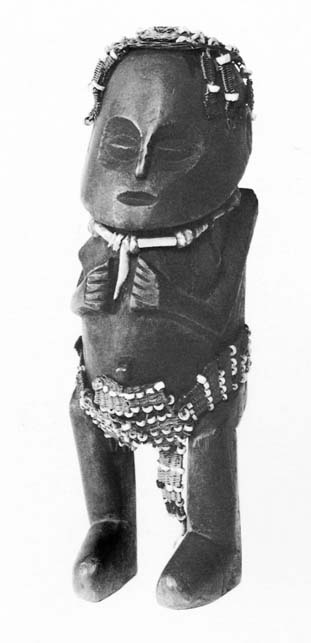 Ethnographic objects could be found in the Museum from the very
beginning since some were part of the original Sloane bequest. But, of course,
not all such objects were exhibited. The basement was crammed with donations
from travelers to exotic parts of the world, and many of these gifts never
succeeded in making their way to the exhibition areas. Still, in the early days
of the Museum, at least one category of ethnographic items was prominently
displayed. In the first decade of the nineteenth century, the Trustees created a
South Sea Room that was very popular with visitors. It used twenty cases to
exhibit the objects brought home by Banks and others from the three Cook
expeditions. But they were not the only indigenous objects on display. Examples
of the material culture of Africa and native America were located in a second
room that also happened to include Egyptian mummies. In an effort to consolidate
the ethnographic objects, the black African and native American items were
transferred in 1808 to the South Sea Room, soon to be renamed the Ethnographical
Room. For the next few decades, however, the collection fell into neglect
because of the open disdain of Museum officials. Panizzi, for example, wished to
be rid of the material entirely. "It does not seem right," he wrote, "that such
valuable space should be taken up by Esquimaux dresses, canoes and hideous
feather idols, broken flints and so on." [12] It was not until
Ethnographic objects could be found in the Museum from the very
beginning since some were part of the original Sloane bequest. But, of course,
not all such objects were exhibited. The basement was crammed with donations
from travelers to exotic parts of the world, and many of these gifts never
succeeded in making their way to the exhibition areas. Still, in the early days
of the Museum, at least one category of ethnographic items was prominently
displayed. In the first decade of the nineteenth century, the Trustees created a
South Sea Room that was very popular with visitors. It used twenty cases to
exhibit the objects brought home by Banks and others from the three Cook
expeditions. But they were not the only indigenous objects on display. Examples
of the material culture of Africa and native America were located in a second
room that also happened to include Egyptian mummies. In an effort to consolidate
the ethnographic objects, the black African and native American items were
transferred in 1808 to the South Sea Room, soon to be renamed the Ethnographical
Room. For the next few decades, however, the collection fell into neglect
because of the open disdain of Museum officials. Panizzi, for example, wished to
be rid of the material entirely. "It does not seem right," he wrote, "that such
valuable space should be taken up by Esquimaux dresses, canoes and hideous
feather idols, broken flints and so on." [12] It was not until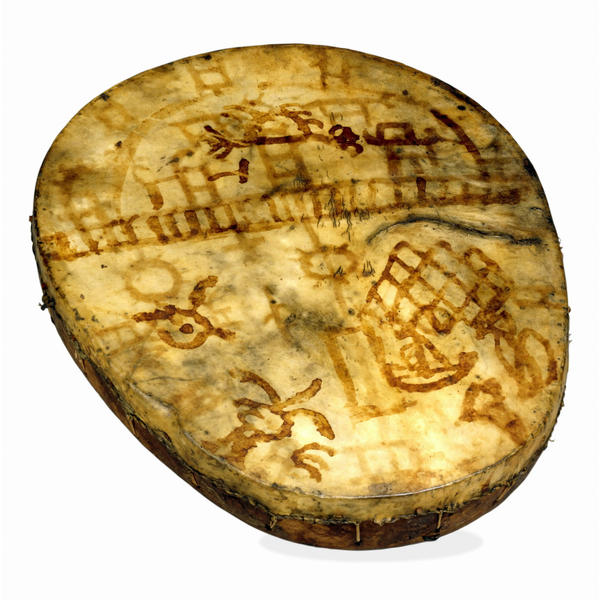 the collection was placed under the directorship of A. W. Franks in
1860 that it found an energetic and effective champion.
the collection was placed under the directorship of A. W. Franks in
1860 that it found an energetic and effective champion.
Since Marx often wandered
through the Museum while taking breaks from his work,[13] it is likely that he
would have seen the ethnographic objects. Moreover, some of these pieces would
have had obvious religious significance, such as the Hawaiian feather gods
Panizzi disparaged, wooden masks from the American Northwest Coast, and jade
tiki figures from New Zealand, all from Cook's voyages. True, the collection
was still in a state of neglect when Marx arrived in 1850. According to The
British Museum, Historical and Descriptive published that year: "The
Ethnographical room [is] an oblong apartment of considerable size, though much
too small for its purpose, which is the collection of articles illustrative of
the manners and customs of nations lying at a distance from our own, as well as
that of rude ancient races."[14] But, however cramped or otherwise poorly
exhibited, the contents of the room would surely have attracted Marx's
attention. As we know from both the Grundrisse and the notebooks he kept
on anthropology in the concluding years of his life, he had a deep and growing
interest in pre-capitalist social formations, including their material
culture.
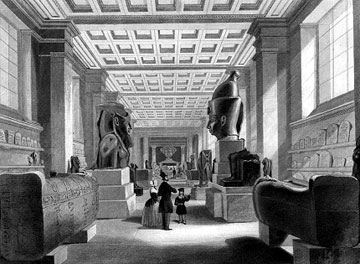 In Marx's mind — consciously or unconsciously — the ethnographic
objects may also have formed a meaningful constellation with others better
displayed, a constellation he had encountered once before. The British Museum
had acquired the core of its Egyptian and Greek collections in the early years
of the nineteenth century. Originally excavated by a team of archeologists that
Napol
In Marx's mind — consciously or unconsciously — the ethnographic
objects may also have formed a meaningful constellation with others better
displayed, a constellation he had encountered once before. The British Museum
had acquired the core of its Egyptian and Greek collections in the early years
of the nineteenth century. Originally excavated by a team of archeologists that
Napol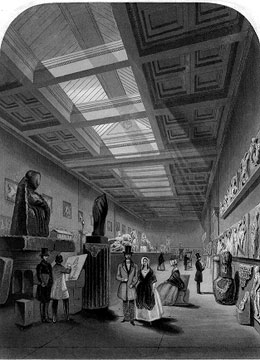 eon had brought along on his Egyptian
campaign, such important items as the Rosetta Stone and the Great Sarcophagus
were captured by the British when they defeated the French armies in Egypt in
1802. By the mid-nineteenth century they were exhibited in the Egyptian
Galleries of the British Museum along with mummies, obelisks, the collosal head
of Ramesses II, and the seated black granite statue of Amenophis III. Around the
time of Napoleon's defeat in Egypt, Thomas Bruce, the seventh earl of Elgin and
ambassador to the Sublime Porte at Constantinople, arranged to have the
sculptures of the Parthenon in Athens shipped back to England supposedly in
order to save these grand achievements of Western civilization from the
depredations of Turkish "barbarism." The marble sculptures, which included the
Parthenon frieze as well as pediments illustrating the birth of the gods, were
displayed in the mid-nineteenth century in the Elgin Room of the British Museum.
The Egyptian Galleries and the Elgin Room were both wildly popular with
visitors. Moreover, they were located close to the new Reading Room which was
itself at the center of the Museum. Marx could not have missed them.
eon had brought along on his Egyptian
campaign, such important items as the Rosetta Stone and the Great Sarcophagus
were captured by the British when they defeated the French armies in Egypt in
1802. By the mid-nineteenth century they were exhibited in the Egyptian
Galleries of the British Museum along with mummies, obelisks, the collosal head
of Ramesses II, and the seated black granite statue of Amenophis III. Around the
time of Napoleon's defeat in Egypt, Thomas Bruce, the seventh earl of Elgin and
ambassador to the Sublime Porte at Constantinople, arranged to have the
sculptures of the Parthenon in Athens shipped back to England supposedly in
order to save these grand achievements of Western civilization from the
depredations of Turkish "barbarism." The marble sculptures, which included the
Parthenon frieze as well as pediments illustrating the birth of the gods, were
displayed in the mid-nineteenth century in the Elgin Room of the British Museum.
The Egyptian Galleries and the Elgin Room were both wildly popular with
visitors. Moreover, they were located close to the new Reading Room which was
itself at the center of the Museum. Marx could not have missed them.
Collectively the indigenous
objects, the Egyptian material, and the Greek sculptures were a kind of three
dimensional illustration of a study Marx had undertaken more than twenty years
earlier. In 1842, Bruno Bauer, his mentor and comrade in the Young Hegelian
movement, commissioned him to write a critique of religious art. In the process
Marx read and made excerpts from Charles de Brosses's treatise on the religious
objects of Africa (with many references to native America) in relation to those
of ancient Egypt. He also read and excerpted works on Greek art. It was the
first time he had studied fetishism.
[1] W.H. Boulton, The Romance of the British Museum
(London: Sampson Low, Marston & Co., LTD.; no date), 14.
[2] Marjorie Caygill, Treasures of the British
Museum (New York: Harry N. Abrams, Inc.; 1985), 186.
[3] J. Mordaunt Crook, The British
Museum (London: Praeger Publishers; 1972), 159-161.
[4] Sir Frank Francis, Treasures of the British
Museum (London: Thames and Hudson; 1971), 18-19.
[5] Quoted in David McLellan, Karl Marx: His Life
and Thought (New York: Harper and Row; 1973), 242.
[6] Karl Marx, Surveys From Exile: Political
Writings: Volume 2, David Fernbach, editor (London: Penguin Books; 1973),
131.
[7] Quoted in The British Museum,
[8] Ibid., 175.
[9] Quoted in McLellan, Karl Marx,
283.
[10] Quoted in ibid., 290.
[11] Karl Marx, Das Kapital, Erster Band
(MEGA, Band 8) (Berlin: Detz Verlag, 1989), 101.
[12] Panizzi quoted in Edward Miller, That Noble
Cabinet: A History of the British Museum (London: Andre Deutsch; 1973),
192.
[13] Karl Marx: A Political
Biography.
[14] Quoted in Miller,
222.
 In 1848 the Parisian masses detonated an international explosion when
they overthrew the constitutional monarchy of Louis Philippe. Gathering under
the red flag, they demanded a "social republic" that would guarantee material
security and good working conditions as well as political liberty. Following
their example, plebeian townspeople all over Europe held meetings, organized
marches, erected barricades, and fought, often successfully, against the regular
armies of the old regimes. Representative assemblies formed in opposition to
royal and aristocratic power as middle-class republicans joined radical workers
and artisans in insurgent though uneasy alliances. In concert with the urban
uprisings, peasants mobilized in the countryside against age-old feudal bonds,
demanding land as well as the most basic political freedoms. In Italy, Hungary,
Poland, and elsewhere, subjugated nations rose against foreign domination in
what became known as "the springtime of the peoples." In number of participants,
as well as sheer geographical extension, the revolution of 1848 was completely
unprecedented. Before it was over, it had involved millions of people in more
than fifty European states.
In 1848 the Parisian masses detonated an international explosion when
they overthrew the constitutional monarchy of Louis Philippe. Gathering under
the red flag, they demanded a "social republic" that would guarantee material
security and good working conditions as well as political liberty. Following
their example, plebeian townspeople all over Europe held meetings, organized
marches, erected barricades, and fought, often successfully, against the regular
armies of the old regimes. Representative assemblies formed in opposition to
royal and aristocratic power as middle-class republicans joined radical workers
and artisans in insurgent though uneasy alliances. In concert with the urban
uprisings, peasants mobilized in the countryside against age-old feudal bonds,
demanding land as well as the most basic political freedoms. In Italy, Hungary,
Poland, and elsewhere, subjugated nations rose against foreign domination in
what became known as "the springtime of the peoples." In number of participants,
as well as sheer geographical extension, the revolution of 1848 was completely
unprecedented. Before it was over, it had involved millions of people in more
than fifty European states. During Marx's first seven years in England, the Reading Room was
located in a cramped, musty space in the north wing of the Museum. Even though
its twenty-six tables were able to accommodate only two hundred and eight
people, there was little attempt to reserve the spots for traditional scholars.
A full range of what Antonio Gramsci was later to call "organic intellectuals"
took advantage of the facilities. In 1852, Bentley's Miscellany
characterized the Reading Room's motley inhabitants with disdainful bourgeois
humor: "Every class of persons haunts the place from the literary lawyer's clerk
to the revolutionary notorieties of Europe. There are hebdomadal humorists
purloining jokes, third-rate dramatists plundering plots, girls copying heads
and flowers."
During Marx's first seven years in England, the Reading Room was
located in a cramped, musty space in the north wing of the Museum. Even though
its twenty-six tables were able to accommodate only two hundred and eight
people, there was little attempt to reserve the spots for traditional scholars.
A full range of what Antonio Gramsci was later to call "organic intellectuals"
took advantage of the facilities. In 1852, Bentley's Miscellany
characterized the Reading Room's motley inhabitants with disdainful bourgeois
humor: "Every class of persons haunts the place from the literary lawyer's clerk
to the revolutionary notorieties of Europe. There are hebdomadal humorists
purloining jokes, third-rate dramatists plundering plots, girls copying heads
and flowers." Still, a crisis point was reached as congestion became acute. At the
same time that the users of the Library came close to exceeding the Reading
Room's limited spatial resources, the collection itself was experiencing the
rapid growth of Panizzi's tenure. So in 1852, the Principle Librarian produced a
sketch for a new and bigger Reading Room.
Still, a crisis point was reached as congestion became acute. At the
same time that the users of the Library came close to exceeding the Reading
Room's limited spatial resources, the collection itself was experiencing the
rapid growth of Panizzi's tenure. So in 1852, the Principle Librarian produced a
sketch for a new and bigger Reading Room. at
least have the outlines clear."
at
least have the outlines clear." Ethnographic objects could be found in the Museum from the very
beginning since some were part of the original Sloane bequest. But, of course,
not all such objects were exhibited. The basement was crammed with donations
from travelers to exotic parts of the world, and many of these gifts never
succeeded in making their way to the exhibition areas. Still, in the early days
of the Museum, at least one category of ethnographic items was prominently
displayed. In the first decade of the nineteenth century, the Trustees created a
South Sea Room that was very popular with visitors. It used twenty cases to
exhibit the objects brought home by Banks and others from the three Cook
expeditions. But they were not the only indigenous objects on display. Examples
of the material culture of Africa and native America were located in a second
room that also happened to include Egyptian mummies. In an effort to consolidate
the ethnographic objects, the black African and native American items were
transferred in 1808 to the South Sea Room, soon to be renamed the Ethnographical
Room. For the next few decades, however, the collection fell into neglect
because of the open disdain of Museum officials. Panizzi, for example, wished to
be rid of the material entirely. "It does not seem right," he wrote, "that such
valuable space should be taken up by Esquimaux dresses, canoes and hideous
feather idols, broken flints and so on."
Ethnographic objects could be found in the Museum from the very
beginning since some were part of the original Sloane bequest. But, of course,
not all such objects were exhibited. The basement was crammed with donations
from travelers to exotic parts of the world, and many of these gifts never
succeeded in making their way to the exhibition areas. Still, in the early days
of the Museum, at least one category of ethnographic items was prominently
displayed. In the first decade of the nineteenth century, the Trustees created a
South Sea Room that was very popular with visitors. It used twenty cases to
exhibit the objects brought home by Banks and others from the three Cook
expeditions. But they were not the only indigenous objects on display. Examples
of the material culture of Africa and native America were located in a second
room that also happened to include Egyptian mummies. In an effort to consolidate
the ethnographic objects, the black African and native American items were
transferred in 1808 to the South Sea Room, soon to be renamed the Ethnographical
Room. For the next few decades, however, the collection fell into neglect
because of the open disdain of Museum officials. Panizzi, for example, wished to
be rid of the material entirely. "It does not seem right," he wrote, "that such
valuable space should be taken up by Esquimaux dresses, canoes and hideous
feather idols, broken flints and so on."  the collection was placed under the directorship of A. W. Franks in
1860 that it found an energetic and effective champion.
the collection was placed under the directorship of A. W. Franks in
1860 that it found an energetic and effective champion. In Marx's mind — consciously or unconsciously — the ethnographic
objects may also have formed a meaningful constellation with others better
displayed, a constellation he had encountered once before. The British Museum
had acquired the core of its Egyptian and Greek collections in the early years
of the nineteenth century. Originally excavated by a team of archeologists that
Napol
In Marx's mind — consciously or unconsciously — the ethnographic
objects may also have formed a meaningful constellation with others better
displayed, a constellation he had encountered once before. The British Museum
had acquired the core of its Egyptian and Greek collections in the early years
of the nineteenth century. Originally excavated by a team of archeologists that
Napol eon had brought along on his Egyptian
campaign, such important items as the Rosetta Stone and the Great Sarcophagus
were captured by the British when they defeated the French armies in Egypt in
1802. By the mid-nineteenth century they were exhibited in the Egyptian
Galleries of the British Museum along with mummies, obelisks, the collosal head
of Ramesses II, and the seated black granite statue of Amenophis III. Around the
time of Napoleon's defeat in Egypt, Thomas Bruce, the seventh earl of Elgin and
ambassador to the Sublime Porte at Constantinople, arranged to have the
sculptures of the Parthenon in Athens shipped back to England supposedly in
order to save these grand achievements of Western civilization from the
depredations of Turkish "barbarism." The marble sculptures, which included the
Parthenon frieze as well as pediments illustrating the birth of the gods, were
displayed in the mid-nineteenth century in the Elgin Room of the British Museum.
The Egyptian Galleries and the Elgin Room were both wildly popular with
visitors. Moreover, they were located close to the new Reading Room which was
itself at the center of the Museum. Marx could not have missed them.
eon had brought along on his Egyptian
campaign, such important items as the Rosetta Stone and the Great Sarcophagus
were captured by the British when they defeated the French armies in Egypt in
1802. By the mid-nineteenth century they were exhibited in the Egyptian
Galleries of the British Museum along with mummies, obelisks, the collosal head
of Ramesses II, and the seated black granite statue of Amenophis III. Around the
time of Napoleon's defeat in Egypt, Thomas Bruce, the seventh earl of Elgin and
ambassador to the Sublime Porte at Constantinople, arranged to have the
sculptures of the Parthenon in Athens shipped back to England supposedly in
order to save these grand achievements of Western civilization from the
depredations of Turkish "barbarism." The marble sculptures, which included the
Parthenon frieze as well as pediments illustrating the birth of the gods, were
displayed in the mid-nineteenth century in the Elgin Room of the British Museum.
The Egyptian Galleries and the Elgin Room were both wildly popular with
visitors. Moreover, they were located close to the new Reading Room which was
itself at the center of the Museum. Marx could not have missed them.